
(Photo: Maryana working up the flaring crack on pitch two of Three Vultures (5.9).)
Summer is flying by.
It is hard to believe I was away from the Gunks for over a month.
Adrian and I were talking about heading up to the Adirondacks this past Saturday, maybe for a death-march one-day spree of climbing. We'd drive up from NYC on Friday night (at least a five hour trip), crash somewhere, climb all day on Saturday and then make the return drive that same evening. For me this sort of arrangement isn't optimal but it means I can go climb somewhere new and not spend the whole weekend away from the family. And as for Adrian? I don't know why he would ever agree to such a miserable plan. For some reason he likes climbing with me, so he's willing to adapt to my needs.
But this past weekend the weather looked iffy and we had arranged no place to stay, so we decided to just go to the Gunks on Saturday instead. And because we were staying local Maryana tagged along as well.
I don't mind climbing in a party of three. It gives the belayer someone to talk to, and if you use double ropes and have both seconds basically simul-climb with a staggered start, three climbers aren't that much slower than two. Also if you like to memorialize your day with photos a party of three can much more easily get decent shots; you have one person who is totally free to roam around and take pictures.
There was one disadvantage to our party of three: we all wanted to lead! As I've previously posted, Maryana is breaking into the 5.9's, just like me. Adrian is no stranger to 5.9 and in the Gunks he's been breaking into 5.10. So we all had similar ambitions for our leading, which led to a little healthy competition and good-natured fighting for position on Saturday.
Somehow I got the first lead of the day without much of a struggle.
I had proposed we head down to the area between the Arrow Wall and CCK. I'll call it the No Glow Wall for lack of a better term. This part of the cliff is similar to the Arrow Wall in that the climbs have high-quality second and third pitches, but sometimes mediocre first ones. The rock leading from the ground to the GT Ledge in this part of the Trapps is generally not terribly steep, and it is rich in horizontal cracks. The grades are pretty moderate; there's nothing much that distinguishes these first pitches from any others in the Gunks. The upper pitches, by contrast, are on this beautiful white marble-like rock, like what you'll find on the upper part of the Arrow Wall and CCK, and there are numerous roofs and other interesting features around which to climb. So the good climbing in this part of the cliff tends to come above the GT Ledge.
The only climbs I'd actually done on this wall before Saturday were No Glow (5.9) and Moonlight (5.6). It is very helpful to have done a route or two on this wall, because unless you can get your bearings the beginning of one route looks much like the next. There is a huge right-facing corner that marks the left end of the wall at the location of the classic easy climb Andrew (5.4). And Moonlight's smaller left-facing corner system is also a helpful landmark on the right end. It also may help you to pick out the vegetated gully that ascends the wall diagonally at the left end; this is Goldner's Grunge, a 4th-class scramble that begins about 35 feet right of Andrew's corner.
I started off our day with pitch one of Three Vultures (5.9), which isn't too far to the right of Goldner's Grunge. I wanted to start with this climb because I knew that the hardest move was right off the ground, and that afterwards the climbing was much easier all the way to the GT Ledge. I was unsure how solid I was going to feel after a month off the real rock. It was also my first day back in the Gunks after my lead fall on Ground Control on July 5, in which I flipped over and mildly sprained a couple fingers. I thought that it would be good for my lead head to get a quick 5.9 tick off the list, and if I couldn't do the opening moves it was no big deal. I'd just hand the lead off to someone else. If I could do them, on the other hand, I would get a nice long warm-up pitch as a reward and receive a confidence boost besides.
I'm happy to say it worked out just as I hoped it would.
The opening step off the ground is the hardest move on the whole route. A good horizontal edge is tantalizingly out of reach. A broken vertical crack starts just above. Some pretty crummy footholds and crimps exist below the good edge. You have to boulder up to it. If you are tall you MIGHT just be able to reach it. Certainly if you're tall the move will be easier. For a short dude like me (5' 7") it required a few abortive efforts to nail the hold, but after trying a couple different approaches I got it. Can I still claim the onsight if my failed efforts were all on the first move?
Whatever, it was good to try the hard move as many times as I liked with no commitment required. Once you get the edge, the route follows a crack up and right. It is a couple more thin moves to a nice hold and the pro. You still aren't that far off the deck; a good spot should suffice until you get the pro in.
And then the rest of the pitch is cake. It continues up and to the right after the opening holds to a bulge. As I stepped to the right of the bulge to place a good nut before pulling over it, I realized that the bulge is kind of contrived. It appears you could easily climb around the bulge to the right. But I had no desire to avoid it so after placing the nut I moved back left and climbed it as directly as possible. There are positive holds; it is probably 5.7 or so in difficulty.

(Photo: At the bulge on pitch one of three Vultures (5.9).)
After the bulge the climb goes straight up the pleasant but unspectacular 5.5-ish face to the GT Ledge. There is a big tree with fixed rappel gear on a ledge about 15-20 feet below the GT Ledge. I chose not to stop there, but to continue instead up to the bigger GT Ledge to build my belay, because it seemed like this would be a better way to find and begin pitch two. These last 15 to 20 feet of the pitch to the GT Ledge are through unpleasant grassy ledges. I had to mantel up on dirt; I couldn't see any way to avoid it. It detracts a bit from what is otherwise a nice enough pitch.
Pitch two (Adrian's lead) turned out to be the money pitch. From the GT Ledge, it goes up a flaring, diagonal crack that turns into an off-width. This crack ends at a ceiling and then atraverse heads right for about 15 feet to a ledge.
I thought this pitch had easier climbing than the hardest moves on pitch one, but it was more sustained and mentally challenging. The hardest part for me was getting up the flared crack. There was one move, just below a fixed piton, in which I actually used off-width technique, wedging my body in the crack and worming upward until I could grab the good holds above. I'm not sure this was actually necessary; Maryana may have climbed the outside of the crack past this section. But it was secure and fun, and an unusual experience for the Gunks.
On the lead Adrian clearly found the move into the traverse to be the crux of the pitch. He stayed there at the top of the crack for a while, fiddling with pro and gingerly venturing out and back, before finally swinging out there and committing. The traverse looks intimidating because it seems there are no good footholds. Dick Williams calls this crux "deceptively easy," and when I tried it I saw what he means. Once you force yourself out there you find that the hands are great, and good footholds are just a move or two away. Large cams help protect the traverse. Definitely bring your blue #3 Camalot. Bringing a bigger cam as well wouldn't be a bad idea. You'll use it for sure.
I suggested to Adrian that he skip the second belay at the end of the traverse and just gun it for the top through the short final 5.5 pitch if the drag isn't too bad, and that is what he decided to do.
Ultimately I thought Three Vultures was a worthwhile route. I would suggest the first pitch to anyone looking for an easy 5.9 to lead. (I still think of myself as such a person even though the list of 5.9's I've led is starting to get kind of long.) But it is not a great pitch. Neither is the third. But the second pitch is really fun and rather unusual for the Gunks. I would like to go back to it again to lead it some time, although I'm unlikely to use the first pitch of Three Vultures to get there. Now that I've done it once there's no real point. I'd be much more inclined to do the first pitch of Moonlight (5.6) or the nearby Erect Direction (5.8), or maybe just rap down to the GT Ledge after finishing another climb.
There is a fixed rap station just to the climber's right of Three Vultures, made of steel cables around trees atop the cliff, directly above No Glow. I have only used this station with two ropes. I am unsure whether you can reach the GT Ledge with a single 60 meter rope-- but I doubt you can. The cliff is very tall here; it may be more than 100 feet from the GT Ledge to the top. I know for certain that you'll need two ropes to reach the ground from the tree on the GT Ledge.
When we returned to the ground I suggested we try Keep on Struttin' (5.9). I thought this would be a good climb for us because like Three Vultures it also has two 5.9 pitches. Dick gives it three stars. I had seen pictures of the crux second pitch, which ends in a traversing section through a multi-tiered roof. I was very excited at the prospect of leading this pitch, but so was Maryana, and she hadn't led anything yet. It was hers if she wanted it.
It is pretty easy to find the start. Not far left of the Moonlight corner, Keep on Struttin' begins directly below a large pine tree with rappel slings that sits about 40 feet up.
Adrian set off on the 5.8 pitch one, about which I'd never heard anything. He made quick work of it, getting all the way to the GT Ledge in no time. Pretty early in the pitch, below the pine at what appeared to be a slightly slabby section, he said "now there's a move right here." But he cruised right through so I didn't think much of it.

(Photo: Adrian about to do the crux moves on the 5.8 pitch one of Keep on Struttin'.)
When I followed him I found out that it is a little bit serious. On the slab below the pine the holds suddenly disappear. Instead of good horizontals there are a couple slippery crimps. And the pro at your feet is a microcam. The sudden difficulty and commitment came as kind of a shock to me. The move is totally doable but I don't know how comfortable I'd feel leading it above my used blue Alien, as Adrian did. In any event, after maybe two moves the climbing returns to the 5.6-ish cruising that you'll find all over this wall. Ultimately I enjoyed the pitch, finding it reasonably clean and straightforward, though nothing special.

(Photo: Maryana at the first roof on pitch two of Keep on Struttin' (5.9). A more difficult roof waits above.)
Pitch two, on the other hand, looked pretty special indeed. From the GT Ledge it appeared tough. Dicey moves up to a roof right off the ledge, then an upward traverse through 5.7 R territory to a bolt, then finally several more overhangs to clear before the belay.
I wasn't feeling timid any more. I wanted this pitch. But Maryana wasn't giving it up. I tried suggesting to her that she'd like the face climbing on pitch three more than the roofs on pitch two, but I couldn't pull it off with a straight face. She knew I was full of it. I was going to be stuck leading pitch three.
There are two ways to start pitch two. To the left of the notch in the roof, the holds look good but there doesn't seem to be any pro. The other option, directly under the notch, offers a bouldery move up to a good pocket that will take a cam, and then another bouldery move up to the overhang.
Maryana chose the approach directly under the notch, and got through it just fine. Then she quickly moved up and left to the bolt. The bolt is visible from the GT Ledge, and there really isn't that big a runout. But it is very blocky/bulgy above the first roof on the pitch and it definitely appears a fall just before clipping the bolt would be a bad idea.

(Photo: Maryana just above the bolt on pitch two of Keep On Struttin' (5.9), about to move left through the final roofs.)
Maryana clipped the bolt and then moved up to the jugs that begin the final set of overhanging moves. She mentioned how tough she thought the moves up to the overhang were. She placed two cams. Then she decided one cam would suffice, and removed one. Then she started to move left and up, but she was worn out; she had to take a hang.
After a rest, she got through the rest of the pitch, placing a lot more pro as she moved left and up through the roofs. I was deeply impressed with her performance. She'd had to rest on gear, but she'd been in control the whole way, and had been very conservative and safe about the lead. I don't think I could have done it any better.
As a follower, I didn't need to stop and rest, but as I climbed I only grew more impressed with the lead. This is the hardest pitch of 5.9 I think I've been on in the Gunks.
It is in your face right away if, like Maryana, you take the right-hand start, with a hard move on crummy, crimpy holds just to get up to the first overhang. Then, later, the moves right after the bolt are, surprisingly, the hardest ones on the pitch. The jugs are right above you but again you have to crimp on a couple thin edges to get up there. You are expecting the pitch to be nothing but a pumpy jug-fest but the cruxes are actually technical and thin. And then, of course, the pumpy jug-fest finally comes and it is no joke.
What an awesome pitch.
I'd gladly go back and lead it tomorrow. I know now, having done it, that the pro is very good for all the hardest bits. I like to think that having previewed it as a second, I could now lead it clean. And if I can't, I'm confident I can keep it in control and take a rest if I need to, just as Maryana did.

(Photo: Pitch three of Keep on Struttin' (5.9). The "bell curve block" is visible at the upper left.)
Pitch three is also rated 5.9, but it isn't nearly as difficult as pitch two. It is also the least serious of the three pitches; the pro is good the whole way.
Of course, I didn't know this as I set off to lead the pitch. Dick Williams describes moving right around an early roof, then getting over a protruding block, and finally the crux-- a move out of a shallow corner above the block.
I could see the early roof directly above me, and the protruding block as well; it is shaped like a bell curve from below. But I couldn't see what was to come above the block and this made me nervous.
As I led the pitch I tried to conserve my gear so I'd have whatever I needed for the crux. It got a little ridiculous; I think I placed three Tricams in an effort to save cams in case I had to throw in a piece later on while gripped.
There was no need for such worry. The pitch is casual and really rather nice. It ascends that wonderful, white, marble-like Arrowish rock. And the moves are interesting, first up a fun right-facing corner, then 5.7-5.8 face climbing around the roof and up to the bell curve block. I wondered as I approached it whether I would need to go left or right around the block; the answer ended up being pretty much straight over.
After the bell curve block I confronted the crux. I don't want to spoil it for you. It is just one move, interesting but not strenuous in the least. I felt it was easy for the grade, frankly, but then both Maryana and Adrian puzzled over it for a bit so maybe it is harder than I think it is.
Pitch three of Keep on Struttin' is a great pitch for a new 5.9 leader. Soft for the grade. But a quality pitch with nice moves and great pro.
In the end, I found the climbing very reasonable on both of these climbs. I walked away from Three Vultures and Keep on Struttin' regretting that I'd drawn the easier 5.9 pitches on both climbs, and thinking that just maybe I'm ready to graduate from "easy" 5.9. Maybe I'm done breaking into the grade, and I can just be a 5.9 Gunks climber now. When I put this thought into action-- say, when I walk up to CCK Direct or Le Teton or MF-- I'll let you know how it goes.

 Meeting Coralia was one of my beautiful experiences in Havana City. I personally think that she is a heroine of the city. In her own right of course. She is Havana’s famous and affable street sweeper and she does her job exceptionally with flair. Such enthusiasm, superb grace and flower fashion that I have never ever seen before. Not from someone who sweeps the city streets while singing the whole day every day.
Meeting Coralia was one of my beautiful experiences in Havana City. I personally think that she is a heroine of the city. In her own right of course. She is Havana’s famous and affable street sweeper and she does her job exceptionally with flair. Such enthusiasm, superb grace and flower fashion that I have never ever seen before. Not from someone who sweeps the city streets while singing the whole day every day.
 Coralia here in action with her broom and dustpan, and of course when she sees a camera nearby, she poses right away!
Coralia here in action with her broom and dustpan, and of course when she sees a camera nearby, she poses right away! Blondine and I with Coralia, the friendly and flower power street sweeper of Havana. She is definitely a Havana street icon.
Blondine and I with Coralia, the friendly and flower power street sweeper of Havana. She is definitely a Havana street icon. I have ridden Marianne for about 50 miles now as a fixed gear, so I figure that I can offer my impressions without feeling that I am speaking too soon. I have taken her both on city rides in traffic and on trails (the Charles River Trail and the Minuteman Bikeway), both with the Co-Habitant and alone. And I think the fixed gear conversion was the best thing that could have happened to this bicycle.
I have ridden Marianne for about 50 miles now as a fixed gear, so I figure that I can offer my impressions without feeling that I am speaking too soon. I have taken her both on city rides in traffic and on trails (the Charles River Trail and the Minuteman Bikeway), both with the Co-Habitant and alone. And I think the fixed gear conversion was the best thing that could have happened to this bicycle.  Popular culture has created the unfortunate association between fixed gear and danger, brightly coloured track bikes, and "hipsters". But that is ridiculous. The only distinguishing feature of a fixed gear bike is that it does not coast. You can turn your loop-frame or your beach cruiser into a fixed gear if you like, set the gearing low, and enjoy pedaling leisurely around town on it. It will be just like a single speed, only you can't coast. That's all.
Popular culture has created the unfortunate association between fixed gear and danger, brightly coloured track bikes, and "hipsters". But that is ridiculous. The only distinguishing feature of a fixed gear bike is that it does not coast. You can turn your loop-frame or your beach cruiser into a fixed gear if you like, set the gearing low, and enjoy pedaling leisurely around town on it. It will be just like a single speed, only you can't coast. That's all. I know that most people enjoy coasting, but I have never been crazy about it. On my regular bicycles I try to always be in a gear that will allow me to pedal. Coasting - especially at high speeds - makes me feel as if the bicycle is a wild horse galloping out of control and dragging me along, with me barely managing to hold on to the reins. This is especially frightening on winding downhills - so I try to switch into a high enough gear that will allow me to pedal, and then I feel that I have better steering control. I have no idea whether this is based on real physical principles, or whether it is all in my head. But the result is that I welcome the "no coasting" aspect of fixed gear bicycles, rather than think of it as a drawback.
I know that most people enjoy coasting, but I have never been crazy about it. On my regular bicycles I try to always be in a gear that will allow me to pedal. Coasting - especially at high speeds - makes me feel as if the bicycle is a wild horse galloping out of control and dragging me along, with me barely managing to hold on to the reins. This is especially frightening on winding downhills - so I try to switch into a high enough gear that will allow me to pedal, and then I feel that I have better steering control. I have no idea whether this is based on real physical principles, or whether it is all in my head. But the result is that I welcome the "no coasting" aspect of fixed gear bicycles, rather than think of it as a drawback.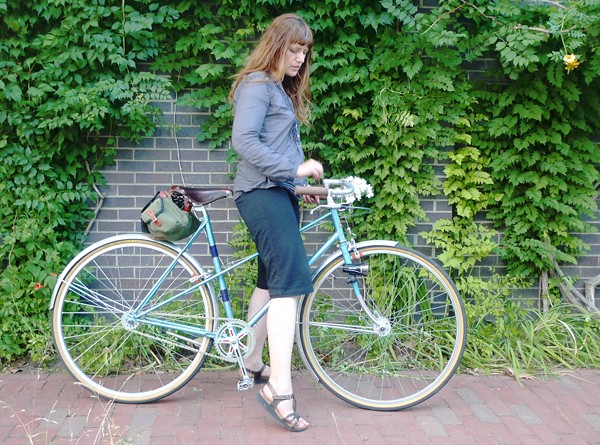 For the same reason, in many ways I find fixed gear bicycles easier to ride, not more difficult. What else is easier about them? Well, remaining stable at very slow speeds - which is a useful skill in the city. You can only coast for so long before your bicycle stops, but if you push on the pedals again, your speed will increase too much. On a fixed gear, you can pedal in slow motion, and the bicycle will remain perfectly stable while going at the exact speed you want, no matter how slow. This is especially useful when you are trying to go around pedestrians, or inch your way forward to the red light at busy intersections. If you have a poor sense of balance and coordination like I do, you may find fixed gear to be helpful in situations that would otherwise leave you flustered.
For the same reason, in many ways I find fixed gear bicycles easier to ride, not more difficult. What else is easier about them? Well, remaining stable at very slow speeds - which is a useful skill in the city. You can only coast for so long before your bicycle stops, but if you push on the pedals again, your speed will increase too much. On a fixed gear, you can pedal in slow motion, and the bicycle will remain perfectly stable while going at the exact speed you want, no matter how slow. This is especially useful when you are trying to go around pedestrians, or inch your way forward to the red light at busy intersections. If you have a poor sense of balance and coordination like I do, you may find fixed gear to be helpful in situations that would otherwise leave you flustered.  As I have mentioned earlier, Marianne was a particularly good choice for a fixed gear bike, because her over-responsiveness is now an asset. As before, she turns super-quickly and easily - but now, she does it only when I want her to and the responsiveness no longer feels like "twitchiness" or "squirreliness". It feels like I now have an extremely maneuverable bike, of which I am in full control - as opposed to a bike that was more maneuverable than I could handle.
As I have mentioned earlier, Marianne was a particularly good choice for a fixed gear bike, because her over-responsiveness is now an asset. As before, she turns super-quickly and easily - but now, she does it only when I want her to and the responsiveness no longer feels like "twitchiness" or "squirreliness". It feels like I now have an extremely maneuverable bike, of which I am in full control - as opposed to a bike that was more maneuverable than I could handle. After a couple of days, we re-did the bars by wrapping the entire surface in cork tape, to allow multiple hand positions. We also removed the rear brake (it really was unnecessary) and placed the front brake lever on the right handlebar for easier access. The bell is now mounted on the stem.
After a couple of days, we re-did the bars by wrapping the entire surface in cork tape, to allow multiple hand positions. We also removed the rear brake (it really was unnecessary) and placed the front brake lever on the right handlebar for easier access. The bell is now mounted on the stem. My gearing on this bicycle is 42-tooth in the front and 19-tooth in the rear (with 170mm cranks and 27" wheels). That is a pretty non-aggressive gearing that is good for everyday cycling in hilly areas. I may get a smaller rear cog eventually (which will allow me to go faster, but will make things more difficult on hills), but I don't feel the need for that yet.
My gearing on this bicycle is 42-tooth in the front and 19-tooth in the rear (with 170mm cranks and 27" wheels). That is a pretty non-aggressive gearing that is good for everyday cycling in hilly areas. I may get a smaller rear cog eventually (which will allow me to go faster, but will make things more difficult on hills), but I don't feel the need for that yet.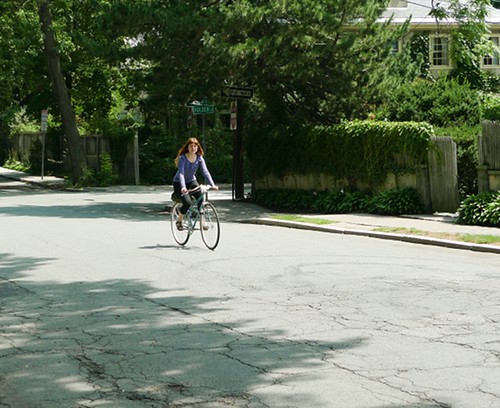 I am sure the novelty of the new Marianne will eventually wear off, but for now I can't seem to stop riding her. After a seat post adjustment (more on this later), the bicycle now feels fairly comfortable on rides under 20 miles. Taking it on a very long ride last night was overkill though, and various parts of my body are now hurting. I think I will stick with the Sam Hillborne for those, and leave Marianne for the city.
I am sure the novelty of the new Marianne will eventually wear off, but for now I can't seem to stop riding her. After a seat post adjustment (more on this later), the bicycle now feels fairly comfortable on rides under 20 miles. Taking it on a very long ride last night was overkill though, and various parts of my body are now hurting. I think I will stick with the Sam Hillborne for those, and leave Marianne for the city.













 I thought this was pretty fitting:
I thought this was pretty fitting: We had a lot of fun together! It was a great day!
We had a lot of fun together! It was a great day!








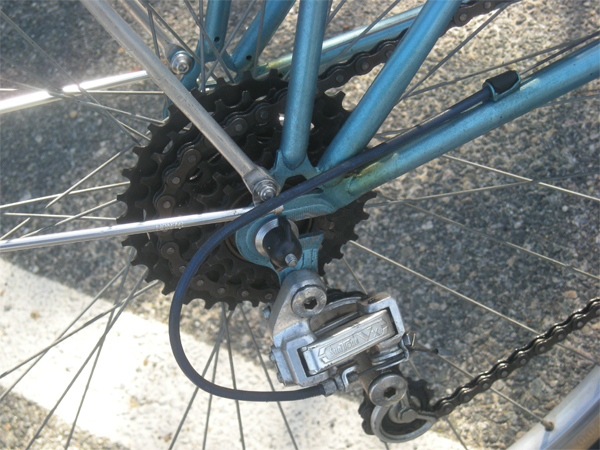 To recap the problem I was having: When downshifting to the lowest gear, there was nothing stopping the chain from going past it and slipping off the cog. Here is how we corrected this:
To recap the problem I was having: When downshifting to the lowest gear, there was nothing stopping the chain from going past it and slipping off the cog. Here is how we corrected this: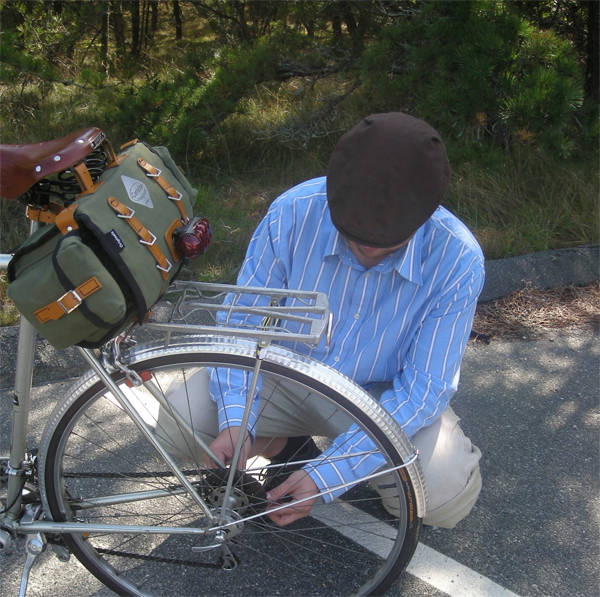 Mechanic
Mechanic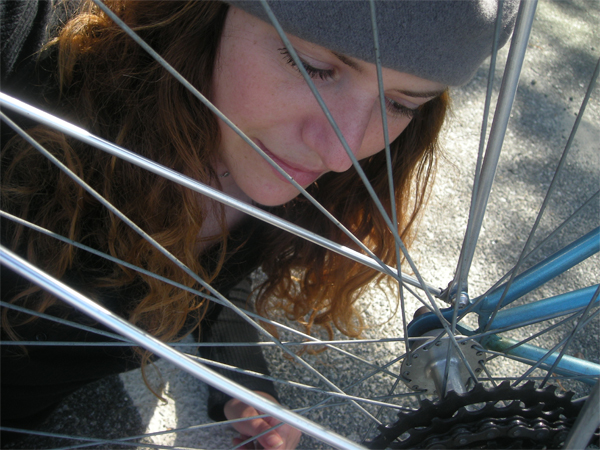 Assistant Mechanic
Assistant Mechanic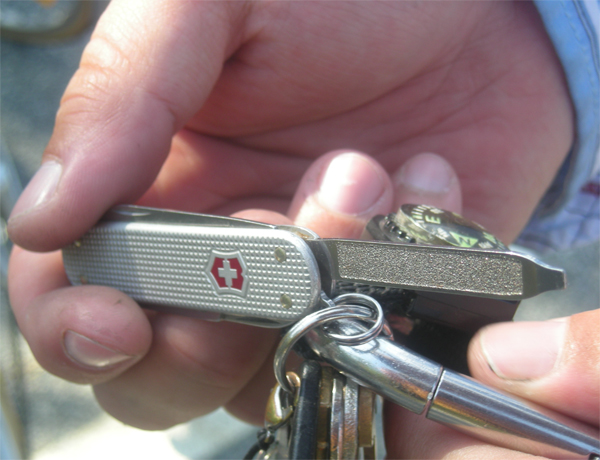 The all-important tool
The all-important tool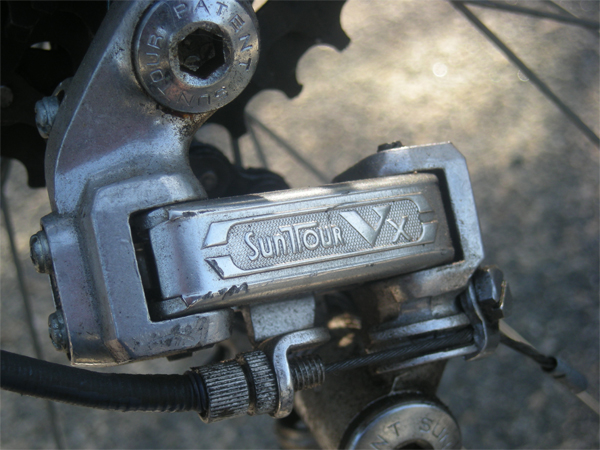 The derailleur. This is a rear SunTour Vx derailleur from the late 1970s. Note the two screws on the left.
The derailleur. This is a rear SunTour Vx derailleur from the late 1970s. Note the two screws on the left.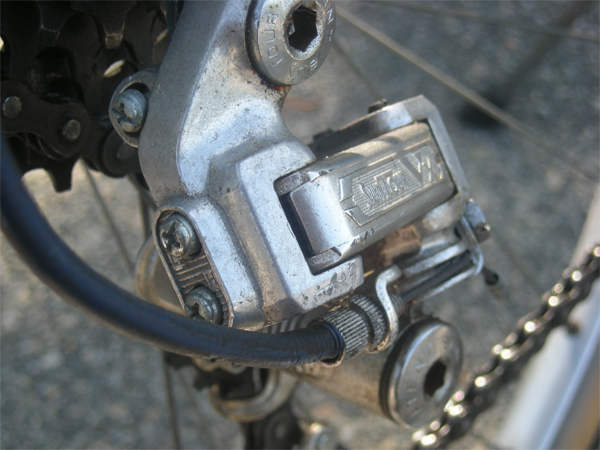 A side view of the screws.
A side view of the screws. And here they are close up. Notice the letters "L" and "H" next to the screws. The "L" indicates low gear (the largest cog). The "H" indicates high gear (smallest cog). To stop the chain from going past the largest cog when downshifting into the lowest gear, tighten the "L" screw.
And here they are close up. Notice the letters "L" and "H" next to the screws. The "L" indicates low gear (the largest cog). The "H" indicates high gear (smallest cog). To stop the chain from going past the largest cog when downshifting into the lowest gear, tighten the "L" screw.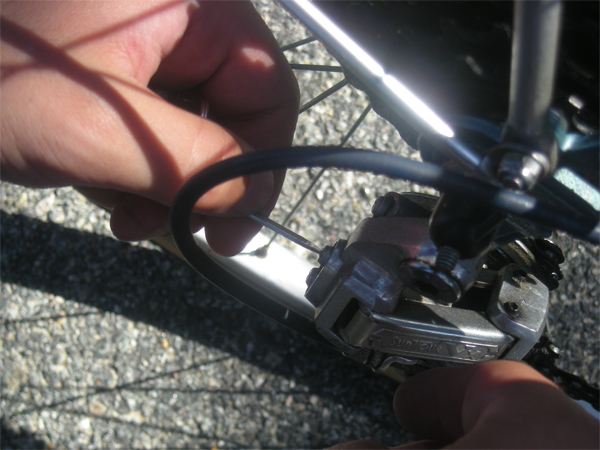 Here is the screw, being tightened. Conversely, if you find that the chain does not travel sufficiently to reach the largest cog when shifting to your lowest gear, you need to loosen this screw a bit. And if you are having this problem when upshifting to the highest gear, simply do the same thing to the "H" screw.
Here is the screw, being tightened. Conversely, if you find that the chain does not travel sufficiently to reach the largest cog when shifting to your lowest gear, you need to loosen this screw a bit. And if you are having this problem when upshifting to the highest gear, simply do the same thing to the "H" screw.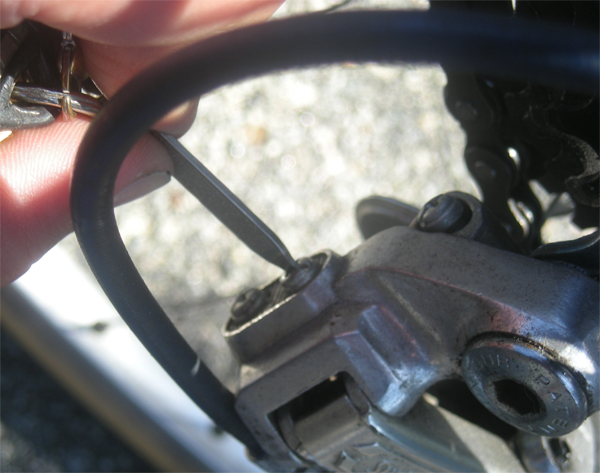 A close-up of the procedure. This takes very little time.
A close-up of the procedure. This takes very little time.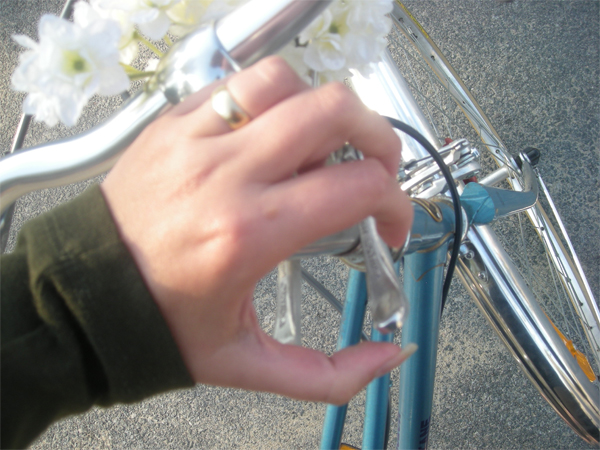 After the adjustment, test the derailleur: first by manually spinning the pedals as you shift, then by test-riding the bike.
After the adjustment, test the derailleur: first by manually spinning the pedals as you shift, then by test-riding the bike. Here I am, having happily shifted into the lowest gear without the chain coming off.
Here I am, having happily shifted into the lowest gear without the chain coming off.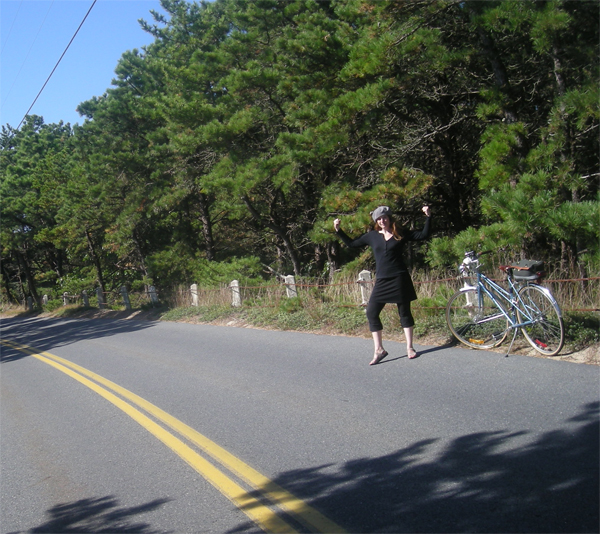 All done, and ready for the steepest hills. A big Thank You again to dukiebiddle, cyclemaniac, somervillain, and all the others who kindly offered advice and posted links. Your support is very much appreciated.
All done, and ready for the steepest hills. A big Thank You again to dukiebiddle, cyclemaniac, somervillain, and all the others who kindly offered advice and posted links. Your support is very much appreciated.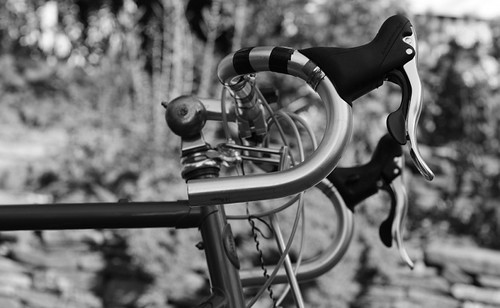 File this under "duh" if you will, but I need to acknowledge this out of fairness to Rivendell, and as a means of providing information to others wondering just how much of an effect one's positioning on a bike can have on pedaling effort and speed. Earlier I described being considerably faster, particularly uphill, on the Seven bicycle I have on loan in comparison to my Rivendell Sam Hillborne. It was widely agreed that there were many factors involved in this difference - from frame geometry, to weight, to positioning. For some time now I'd been considering making changes to my Rivendell, and finally it's been done - thus somewhat leveling the playing field between the two bikes, with interesting results.
File this under "duh" if you will, but I need to acknowledge this out of fairness to Rivendell, and as a means of providing information to others wondering just how much of an effect one's positioning on a bike can have on pedaling effort and speed. Earlier I described being considerably faster, particularly uphill, on the Seven bicycle I have on loan in comparison to my Rivendell Sam Hillborne. It was widely agreed that there were many factors involved in this difference - from frame geometry, to weight, to positioning. For some time now I'd been considering making changes to my Rivendell, and finally it's been done - thus somewhat leveling the playing field between the two bikes, with interesting results.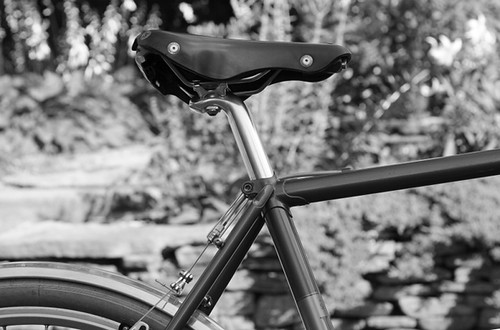 We've also reduced the amount of setback on the saddle by about 2 cm (not just by moving the saddle forward, but by replacing the seatpost). The overall effect is that my lean has increased by a small amount, my weight on the bike has shifted forward, and my hips are move directly above the cranks.
We've also reduced the amount of setback on the saddle by about 2 cm (not just by moving the saddle forward, but by replacing the seatpost). The overall effect is that my lean has increased by a small amount, my weight on the bike has shifted forward, and my hips are move directly above the cranks.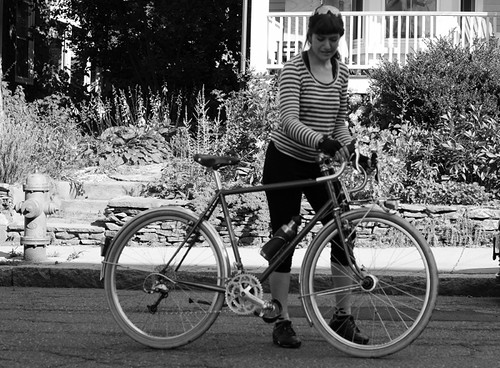 We rode to Lexington, MA to try some hill intervals. I did not attach a saddlebag, so that I could get a sense of how the bike itself performs. And it performed well - albeit differently from the Seven.
We rode to Lexington, MA to try some hill intervals. I did not attach a saddlebag, so that I could get a sense of how the bike itself performs. And it performed well - albeit differently from the Seven.